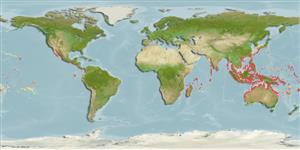Environment: milieu / climate zone / depth range / distribution range
Ecology
Marine; brackish; reef-associated; depth range 0 - ? m. Tropical
Pacific Ocean: ranging eastward to the Gilbert Islands and Samoa, north to southern Japan. Confused with Hemiramphus archipelagicus under the name Hemiramphus marginatus by many authors (Ref. 10943).
Length at first maturity / Size / Weight / Age
Maturity: Lm 22.6, range 22 - 23.6 cm
Max length : 40.0 cm SL male/unsexed; (Ref. 54980); common length : 25.0 cm SL male/unsexed; (Ref. 9843)
Dorsal spines (total): 0; Dorsal soft rays (total): 12 - 15; Anal spines: 0; Anal soft rays: 10 - 13; Vertebrae: 52 - 57. Greatly prolonged, beak-like lower jaw; upper jaw short, triangular and without scales; preorbital ridge absent; total number of gill rakers on first gill arch 33-46; pectoral fins long, reaching beyond anterior margin of nasal pit when folded forward; no spots or vertical bars on sides.
Inhabits coastal waters rich in vegetation (Ref. 5213). Found more offshore than other species of Hemiramphus in the western central Pacific; juveniles and immature individuals are relatively common far from shore, usually among floating plants (Ref. 9843). Caught by set-net.
Life cycle and mating behavior
Maturities | Reproduction | Spawnings | Egg(s) | Fecundities | Larvae
Collette, B.B. and J. Su, 1986. The halfbeaks (Pisces, Beloniformes, Hemiramphidae) of the Far East. Proc. Acad. Nat. Sci. Philadelphia 138(1):250-301. (Ref. 10943)
IUCN Red List Status (Ref. 130435)
Threat to humans
Harmless
Human uses
Fisheries: minor commercial
Tools
Special reports
Download XML
Internet sources
Estimates based on models
Preferred temperature (Ref.
123201): 24.3 - 29.3, mean 28.4 °C (based on 3275 cells).
Phylogenetic diversity index (Ref.
82804): PD
50 = 0.5005 [Uniqueness, from 0.5 = low to 2.0 = high].
Bayesian length-weight: a=0.00437 (0.00193 - 0.00988), b=3.08 (2.90 - 3.26), in cm total length, based on LWR estimates for this Genus-body shape (Ref.
93245).
Trophic level (Ref.
69278): 3.4 ±0.5 se; based on size and trophs of closest relatives
Resilience (Ref.
120179): High, minimum population doubling time less than 15 months (Preliminary K or Fecundity.).
Fishing Vulnerability (Ref.
59153): Moderate vulnerability (39 of 100).
